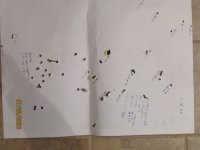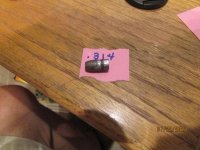A few weeks ago I got in a day at the range shooting two of my antique rifles; a Marlin 1889 in 38-40, circa 1894 and a "new to me" Marlin 1889 32-20 rifle circa first year production. The 38-40 was on target at 50 yards and the 32-20 was all over the target. What to do? The rifling in the 32-20 is very strong although bore is typical of a black powder dark bore. I know that antique rifles often have bores all over the map when size of bore diameter is in question. I was shooting .312 diameter cast lead bullets with poor performance as seen in the photos. The 38-40 gave me no problems and printed good groups at 50 yards (top half of target). A lot of the .312 bullets tended to tumble or keyhole (back of target). My first response was that I needed to slug the barrel. That was the next step and looking at my stash of 32 cast bullets I chose 3 to slug down the barrel. See bullet photos. All of the cast bullets were scored by the rifling, some more than others. I have been trying to decide which diameter is best to reload for an accuracy test or just load a dozen of each and do some bench type shooting at the next range visit. These two rifles are a piece of history, the
38-40 is 129 years old and the 32-20 is 134 years old. What do I do to make the old 32-20 shoot better?
38-40 is 129 years old and the 32-20 is 134 years old. What do I do to make the old 32-20 shoot better?








